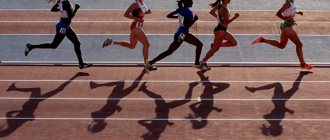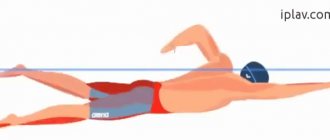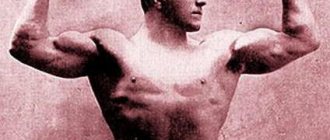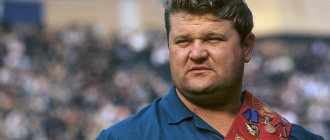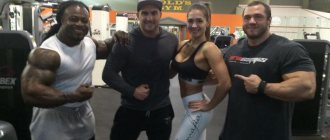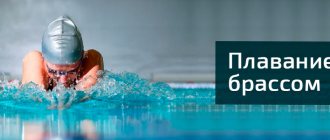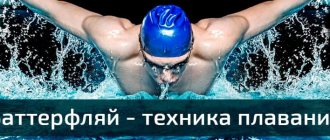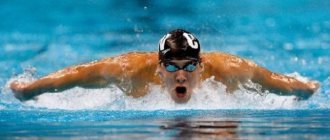Which of these functions does swimming serve in your life?
- Training the back muscles during sedentary work;
- Professional sports, participation in competitions;
- Rehabilitation as prescribed by a doctor;
- Hardening, general strengthening of the body;
- Relaxation during summer holidays.
The selected item determines which types of swimming are best for you to master. We will look at each swimming style separately and try to choose the best one for you!
First on our list is Freestyle (Crawl)
The rabbit has been known to the world since primitive times. And yet, American and European athletes for a long time did not suspect anything about crawl; they lived giving priority to another style of swimming - breaststroke. The West was able to “get acquainted” with the freestyle in a new way in 1844 at competitions in British London, where athletes who swam the freestyle easily beat the famous athletes who swam the breaststroke. Europeans for a long time categorically rejected the crawl method of swimming. Soon (in the 1870s), the Englishman John Tregen, traveling around Argentina, mastered the crawl technique from the indigenous local population and a few years later showed the crawl at competitions in Britain (by the way, John only mastered hand movements from the Indians - he did everything with his feet I also worked in the horizontal plane, breaststroke). Following his example, this technique was improved by the Dick brothers and Toomes Cavill from Australia. They were greatly influenced by the way of navigation of the Solomon Islanders. The so-called “Australian crawl” that arose in this way was modified a little later by the American Charles Daniels, who also included six-beat kicks. Thus, Daniels created the “American crawl”, from which the modern style develops. It is used in teaching swimming to adults. So, crawl (from the English crawl - “crawl”) is a style of swimming on the chest, in which the swimmer must make wide strokes parallel to the body, alternately with the left and right hands, raising the legs continuously and alternately. The athlete's entire face is always in the water, and only during one of the strokes does the swimmer turn his head to take a breath for the subsequent swim. Freestyle training at the SwimLife swimming school in Minsk - individual lessons
How to swim underwater correctly
Scuba diving deserves special attention. modified versions of the butterfly or breaststroke are best used for moving underwater :
- In the underwater butterfly, the arms are extended forward in an arrow; advancement under water is due to wave-like movements of the body and legs.
- In underwater breaststroke, the arms are not thrown forward after the stroke, but are placed along the hips, then, during the kick, they are smoothly brought forward for subsequent sliding.
Backstroke swimming.
Swimming on the back or crawl on the back is a style of swimming that is technically similar to the crawl (arms make alternate strokes, legs make a continuous, alternating rise / fall), but has the following differences: a person swims on his back, not on his stomach, and carries over water is performed with a straight arm, and not bent, as in the crawl. The third fastest swimming style at distances up to 200 meters. The peculiarity of this method is that the person does not need to exhale into the water, since the face is on the surface. Another feature of the style is that the start is made from the water, and not from the bedside table, as in all other styles.
Other varieties
The above styles are considered the most optimal and healthy ways to move in the water.
Other varieties that are in demand can also be mentioned:
Swimming doggy style
- Doggy style is not a highly recommended option , which, however, in some cases can be used as an auxiliary exercise.
- On the side - mainly used as an exercise , but in some cases it can also act as an independent method.
History of the crawl style of swimming
The backstroke was included in the Olympic Games in 1904. Initially, only men competed in this event. Beginning in 1924, women began to swim on their backs. The first swimmers performed simultaneously stroke movements with their arms and movements with their legs, reminiscent of breaststroke. A stroke was performed with straight arms at the surface of the water. Next, the hands were raised and placed in the water behind the head, parallel to each other. The legs, previously bent at the knees, made a stroke with the inner surface of the foot, straightening the knees first to the sides and then inwards. At the 1912 Olympic Games, it was proven that swimming the backstroke gives a speed advantage over the breaststroke. At the Stockholm Olympics, American Harry Hebner first used alternating arm work in combination with leg movements similar to the movements of the Australian crawl. This swimmer laid the foundation for the development of the backstroke, which is actively used and taught by coaches in many swimming schools in Minsk.
Theory and practice
As you know, theory without practice is dead or fruitless, and practice without theory is ineffective or harmful. Therefore, in order to learn to swim on your own, it is worth reading the theoretical developments and then putting them into practice.
But if you don't have the motivation, then fear or prejudice can stop a person. To do this, let us mention the positive qualities of swimming:
- breathing develops (we train the lungs);
- the heart and blood vessels are strengthened;
- the body's metabolic processes are accelerated;
- muscles build up, immunity improves, and the nervous system strengthens.
As you can see, there are many bonuses, and to start bringing the idea to life, people can contact a trainer, or, for safety, start training in a pool in shallow water.
Swimming style breaststroke
Breaststroke is a style of front swimming in which the arms are simultaneously extended symmetrically forward, and the legs, with the feet turned outward, simultaneously push back. Breaststroke swimming technique is quite complex. The cycle of movements consists of one simultaneous, symmetrical movement of the arms (similar to the movement in butterfly), movement of the legs and one inhalation and exhalation into the water.
Body position when swimming breaststroke
The angle of attack changes throughout the cycle. The most horizontal and elongated position of the body during the slide following the push of the legs. At the moment of entering the water, the maximum angle of attack of the body is noted, reaching 15 -18.
Hand movement during swimming training
- During breaststroke swimming, the hands set the pace; they are closely related to the athlete’s breathing and influence the overall coordination of movements. The cycle of arm movement can be divided into three phases: First, moving the arms forward, the preparatory phase. The arms are straightened and the swimmer sends the arms forward along with the shoulder girdle, the palms almost touch each other and smoothly turn palms down to create a moving support.
- Secondly, swell or slide. The arms are fully extended and the athlete moves forward in an extended position. The brushes at this moment should be as close to the surface of the water as possible.
- Thirdly, the working movement - the stroke - can also be divided into the following stages:
- In the preparatory stage, the arms move forward, the palms turn outward. Then the arms begin to bend at the elbows, the elbows take a high position, turn to the sides, the angle between the surface and the hand - forearm is approximately 45, but it is worth noting that the breaststroke swimming technique is individual.
- During the main cycle of the working movement - repulsion - the hands perform their accelerated movement along a spherical trajectory - outward, and then, creating support on the water back. By this time, the hand-forearm is already tilted at an angle of 60 degrees. The hands continue the supporting sliding movement downwards and inwards towards each other and turn around, behind the hands the elbows move with acceleration in the same direction. The push-off is the fastest and most powerful part of the movement cycle.
- The final stage of the stroke is bringing the arms together at the chest. The hands rush inward, forward, upward and come together under the chin, the elbows come together under the chest. At this moment, an inhalation is performed.
Leg movement during swimming
Leg movements in breaststroke differ significantly from other types of leg movements. In breaststroke there are very fast preparatory movements towards oneself and a sharp push back and to the side from the water.
Leg movements are divided into phases:
- Pull-up, the preparatory phase of the movements, begins with bending the relaxed legs at the knees and slight flexion at the hip joints. The knees move down and to the side, the feet move towards the surface of the water at approximately the width of the pelvis. The final part of the pull-up is performed more energetically: the legs are significantly bent at the hip and knee joints, the knees are spread apart to a distance exceeding approximately one and a half times the width of the pelvis, at the end of the foot the toes are quickly spread outward, after which the swimmer immediately begins kicking.
- Labor movement, strike. By the beginning of the kick, the legs are bent at the hip joints, the angle between the thigh and the body can be close to straight and depends on the individual characteristics of the swimmer. The shins occupy a position perpendicular to the surface of the water (the angle between the shin and thigh is about 45). The knees are separated slightly more than the width of the pelvis (the degree of separation of the legs can also vary depending on individual characteristics), the feet are turned with their toes to the sides. During the impact - the energetic simultaneous extension of the legs at the hip and knee joints - the feet move in arcs back-outward, and then back-inward. The feet finish moving along a trajectory directed slightly downward, as a result of which they end up 20-30 cm below the surface of the water. During a kick, the pelvis is rigidly fixed, the back is straight.
- Slip. After the blow is completed, the thighs and shins immediately relax and seem to float to the surface of the water, maintaining a well-streamlined position. As speed increases, the sliding phase shortens. Thus, the maximum quality of the breaststroke style is achieved in teaching swimming for children and adults. Breaststroke style - teaching swimming to adults at the SwimLife swimming school in Minsk, example
Movement of arms and legs
You need to master the movements of your limbs from your feet. To learn how to swim breaststroke as an adult, you need to hold onto the side of the pool and make movements like a frog. A person begins to use his hands reflexively.
The crawl requires different leg movements. They are faster and sharper, with an elongated toe. For good results, you can use a swimming board.
Butterfly swimming style
Dolphin is a fast butterfly stroke. Butterfly is a swimming style in which the athlete performs simultaneous and symmetrical movements with both parts of the body. With both hands, the swimmer performs a powerful long stroke; when performing it, the upper part of the body rises above the water, while simultaneously performing symmetrical kicks. This style is considered the second fastest after the crawl. The dolphin swimming method is a high-speed variation of the butterfly style. The dolphin's swimming technique is distinguished by the movement of its legs: they move up and down in a vertical plane (similar to the movements of a dolphin's tail). In classic butterfly, the legs work in the breaststroke. Next is the betterfly swimming technique. The movements are performed symmetrically: the hands make a stroke in the water, and then simultaneously sweep over the water; the legs and torso perform active wave-like movements. The most widespread is the two-strike dolphin, where the cycle of movements consists of one stroke with the arms, two kicks with the legs, inhalation and exhalation.
Body position during butterfly
Starting position on the chest, shoulders parallel to the surface of the water, face down. The angle of attack when swimming is constantly changing and takes a value from -20 at the end of the downward kick to 20 at the moment the arms move above the water.
Movement of the legs and torso in swimming
The swimmer performs wave-like movements of the legs and torso with an ever-increasing amplitude from the shoulders to the mid-torso, from the mid-torso to the pelvis, from the pelvis to the hips, from the hips to the lower legs and feet. The entire cycle of wave-like movements ends with a strong kick of the feet from top to bottom (this is the main working movement of the legs). When the feet make an overwhelming downward blow, the pelvis rises up; during the upward movements of the legs and feet, the pelvis energetically moves down, the shoulder girdle moves forward and slightly upward. When swimming with a two-stroke dolphin, the wave-like movements of the upper body in the second half of the cycle at the end of the stroke are minimized, since the swimmer must keep his shoulders near the surface and ensure that his arms are carried above the water. Therefore, the amplitude of pelvic movements should be sufficient to ensure the transmission of wave-like movements to the legs, but not too strong so as not to cause swaying of the shoulders. Movements of the legs play a coordinating role and make a significant contribution to the creation of driving forces: when a dolphin swims using movements with only legs, approximately 70% of the swimming speed with full coordination of movements is achieved.
Hand movement when swimming dolphin style
When swimming in the dolphin way, the hands serve as the main driving force: when swimming using movements with one hand, 90% of the swimming speed is achieved with full coordination. The hand movement cycle can be divided into phases:
- Carrying or moving your arms above the water. The carry is performed by swinging forward from the sides with almost straight, relaxed arms, while the shoulders are raised above the water. Towards the end of the phase, the hands turn palms down and outwards, and the elbows turn so that the water touches the hands first.
- Hands entering the water. The swimmer sends his arms and shoulder girdle forward into the water, his arms entering the water shoulder-width apart.
- The supporting part of the stroke. During the support phase, the arms begin to bend, the hand and forearm perform an advanced support movement in relation to the elbow in the forward-outward-downward direction. By the end of the phase, the hands diverge to the sides about 1.5-1.7 times wider than the shoulders, the arms are slightly bent at the elbow joints (up to 130-140), the hand-forearm plane in relation to the surface of the water is at an angle of about 45. The main part stroke. The elbows are moved outward, a powerful stroke is performed due to active flexion-extension at the elbows and powerful adduction and extension of the shoulders. By the end of the first half of the stroke - pull-up - the angle of bending of the arms at the elbows reaches 90, the hands come closer together. In the second half of the stroke - push-off - the movement becomes even more powerful; by the end of the phase, the elbows are brought towards the body, the hands move near the pelvis.
- Hands coming out of the water. The hands relax at the hips, the arms are carried out with a quick movement, with the elbows appearing above the water first. The hands emerge from the water behind the pelvic line and slightly away from the hips. Swimming for children and adults - butterfly style at the SwimLife school in Minsk. Swimming lessons for children from 3 years old!
Muscles involved
Main article: What muscles work when swimming crawl
The crawl primarily targets the deltoids of the shoulders, the latissimus dorsi, the quadriceps in the legs, and the triceps in the arms.
In total, more than 20 different muscle groups , and swimming with this style itself is very useful. Read more about this in our article.

